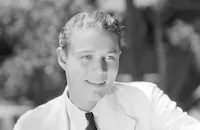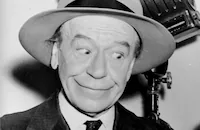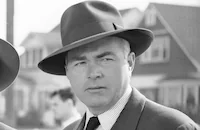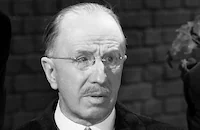Society Doctor

Brief Synopsis
Cast & Crew
George B. Seitz
Chester Morris
Robert Taylor
Virginia Bruce
Billie Burke
Raymond Walburn
Film Details
Technical Specs

Synopsis
At the Metropolitan Hospital, where Horace Waverly is Physician Superintendent, doctors Bill Morgan and Tommy Ellis vie for the attention of nurse Madge Wilson. One day, Frank Snowden, son of the wealthy and influential Harris Snowden, is brought in with an acute case of appendicitis, which requires immediate surgery. Harris insists on waiting for Dr. Harvey, their family physician, to arrive and give his opinion of the matter, but Dr. Morgan performs the urgent operation after quickly securing the consent of Frank's wife. When Dr. Morgan is reprimanded by Waverly for taking Dr. Harvey's patient and is dismissed from the hospital, he angrily criticizes Waverly's and Harvey's unethical behavior, accusing both of serving only the petty whims of the rich and obstructing basic medical care for the sick and injured. One of Metropolitan's wealthiest resident patients is the chronically lonely Mrs. Crane, who, after learning of the young doctor's dismissal, uses her influence to have him reinstated. Meanwhile, two reporters arrive at the hospital and wait for the impending arrival of gangster Butch McCarthy, who has been released from prison for one day to visit his hospitalized mother. The reporters try to get the story about how Waverly has kept the con's visit a secret, especially considering that police officer Harrigan, who is being treated for the gunshot wounds from Butch's gun, is on the same floor. Dr. Morgan spoils Madge and Dr. Ellis' plans for a date when a staff shortage requires him to instruct Ellis to stay at the hospital. The eager Dr. Ellis proposes marriage to Madge, but she tells him that she is in love with Dr. Morgan. Later, when Dr. Morgan learns that his reinstatement came not from his own merit as a physician, but from Mrs. Crane's doings, he decides to leave the hospital in the name of saving his self-respect. Mrs. Crane wants Dr. Morgan to be her physician, so she offers to set him up in a private practice and keep him in business by sending her rich friends to him. Seeing no other alternative, Dr. Morgan accepts the offer, but when Madge finds out about his decision and believes that he has acted out of greed, not self-respect, she spurns him and agrees to marry Dr. Ellis. Escorted by the police, Butch McCarthy is brought to the bedside of the woman who is supposedly his mother, but once his handcuffs are removed, he grabs the gun that was smuggled in by the phony patient and goes after Harrigan. After Dr. Morgan is shot by the convict while trying to stop him, Harrigan's wife succeeds in preventing her husband's murder by shooting Butch. Dr. Morgan is rushed to the operating table, where it is discovered that the nature of his bullet wound is so severe that all hope for his recovery is abandoned. However, the still-conscious Dr. Morgan pleads with Dr. Ellis to perform a method of operation that only they have studied at the hospital. Dr. Ellis agrees, and under Dr. Morgan's guidance, the risky operation begins. During the procedure, Dr. Morgan tells Madge that he had reconsidered Mrs. Crane's offer and turned it down, thus fully redeeming himself. When the operation ends successfully, Dr. Ellis insists that Dr. Morgan ask Madge to marry him, and she accepts.

Director
George B. Seitz
Cast

Chester Morris

Robert Taylor

Virginia Bruce

Billie Burke

Raymond Walburn

Henry Kolker

Dorothy Peterson

William Henry
Mary Jo Matthews

Robert Mcwade

Donald Meek
Louise Henry
Johnny Hines

Addison Richards
Bobby Watson
Arthur Vinton
Eulalie Jensen
Wade Boteler

James Flavin
Libby Taylor
Claudelle Kaye
Jean Chatburn

Arthur Hoyt
Claudia Coleman
Bert Roach
Ines Palange
Richard Tucker
Perry Ivins
Lee Shumway
Gladden James
Allen Connor

Edward Norris
Ernie Alexander
Heinie Conklin
Crew
Howard Campbell
Michael Fessier
Cedric Gibbons
Lucien Hubbard
Ben Lewis
[dr.] Thomas F. Maclaughlin
Samuel Marx
Oscar Radin
Douglas Shearer
Lester White
Edwin B. Willis

Film Details
Technical Specs

Articles
Society Doctor
Based upon an unproduced play The Harbor by Theodore Reeves, with a screenplay by Michael Fessier and Samuel Marx, and directed by George B. Seitz, Society Doctor was shot quickly in a few weeks between Thanksgiving and Christmas 1934 under the working titles of Ambulance Call and Only Eight Hours (the latter being the title the film was reviewed under in several newspapers before being changed at the last minute to Society Doctor).
The clichéd plot points are familiar to anyone who has ever seen a medical film produced in the 1930s: the earnest young physicians who vie for the attentions of the beautiful nurse, the jab at the medical profession's pandering to the rich at the expense of the poor, and the professional jealousy between doctors.
The film had been announced with stars Clark Gable and Fay Wray in the leads, but Gable was reassigned elsewhere and Wray was noted by The Hollywood Reporter as having "skipped out" on the role before production began. Society Doctor was then assigned to Morris and Bruce, with Taylor in a supporting role as Morris' best friend (and rival for Bruce). After screening the film at the studio, Mayer was so impressed with Taylor that he promoted the young actor to leading roles. The increase of fan mail for Taylor after this film was released sealed the deal.
The critical reaction to Society Doctor was lukewarm at best. Variety called it "another effort to bring in a second Men in White (1934), which fails to pack enough of a plot wallop in the opening to gain the necessary interest. It's implausible and frequently drags because it is necessary to pad out until enough time has been spent to bring it to a close." The New York Times' film critic said the film "is played in spotless white and with an appropriate sense of glamour and nobility by Chester Morris, Virginia Bruce and a promising newcomer, Robert Taylor. It impressed this column as an ecstatically foolish fable, but who is one against so many?" Critic Kate Cameron prophetically wrote that "in a market where young leading men are so scarce a commodity that the same players are used over and over again until one is likely to grow weary of the same faces, the appearance of an actor with the potentialities of young Mr. Taylor is to be hailed with cheers. Clark Gable, Robert Montgomery, Franchot Tone, Gene Raymond, Gary Cooper, Joel McCrea and Chester Morris, push over and make room for Robert Taylor!"
Producer: Lucien Hubbard
Director: George B. Seitz
Screenplay: Michael Fessier, Samuel Marx; Theodore Reeves (play "The Harbor")
Cinematography: Lester White
Art Direction: Cedric Gibbons
Music: R.H. Bassett (uncredited)
Film Editing: Ben Lewis
Cast: Chester Morris (Dr. Bill Morgan), Robert Taylor (Dr. Tommy 'Sprout' Ellis), Virginia Bruce (Madge Wilson), Billie Burke (Mrs. Crane), Raymond Walburn (Dr. Horace Waverly), Henry Kolker (Dr. Harvey), Dorothy Peterson (Mrs. Kate Harrigan), William Henry (Frank Snowden), Mary Jo Matthews (Mary Roberts), Robert McWade (Harris Snowden), Donald Meek (Moxley), Louise Henry (Gail - telephone operator), Johnny Hines (Reporter Hardy), Addison Richards (Pete Harrigan), Bobby Watson (Reporter Albright).
BW-67m.
by Lorraine LoBianco
SOURCES
The AFI Catalog of Feature Films, 1931-1940
The International Dictionary of Films and Filmmakers
"Society Doctor at the Mayfair" The New York Times 4 Feb 35
Variety Film Reviews 1934-1937

Society Doctor
Quotes
Blue blood isn't immune to gangrene.- Dr. Morgan
Trivia
Notes
Working titles for this film were Ambulance Call and Only Eight Hours. The picture was reviewed as Only Eight Hours by several trade papers. Society Doctor marked Robert Taylor's first starring role for M-G-M. He was called "a promising young newcomer" in the New York Times review. According to Hollywood Reporter pre-production news items, Clark Gable was originally announced as a star of the film. Dr. Thomas F. MacLaughlin, a member of the medical staff at St. Bartholomew's Hospital in London, worked on this film as a technical advisor. A Hollywood Reporter pre-release news item noted that Virginia Bruce was handed the female lead after Fay Wray "skipped out" on her part. Hollywood Reporter production charts list actor Sid Silvers in the cast, but his appearance in the released film has not been confirmed. The file for Society Doctor in the MPAA/PCA Collection at the AMPAS Library indicates that before the film was released in Italy, Italian censors deleted footage containing the scene in which a woman with an Italian name conceals a knife under her shawl while going to visit her husband in the hospital.















